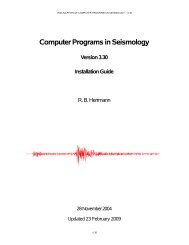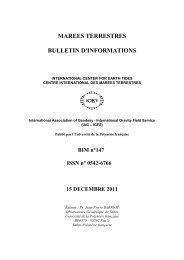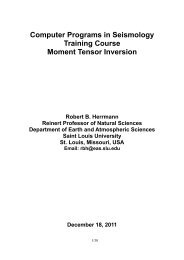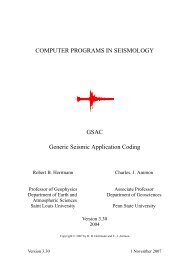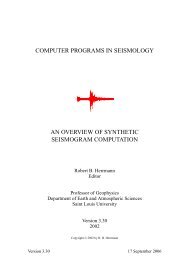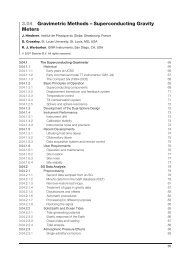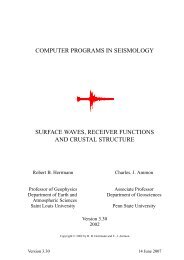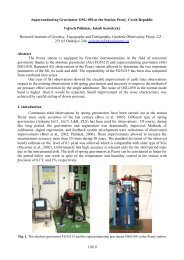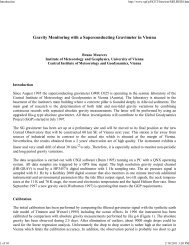LLR and Tidal Effects - the Department of Earth and Atmospheric ...
LLR and Tidal Effects - the Department of Earth and Atmospheric ...
LLR and Tidal Effects - the Department of Earth and Atmospheric ...
Create successful ePaper yourself
Turn your PDF publications into a flip-book with our unique Google optimized e-Paper software.
epproo10<br />
http://www.upf.pf/ICET/bim/text/WG6<strong>LLR</strong>.htm<br />
1 <strong>of</strong> 5 2/18/2011 3:26 PM<br />
<strong>LLR</strong> <strong>and</strong> <strong>Tidal</strong> <strong>Effects</strong><br />
Subgroup on <strong>LLR</strong> <strong>of</strong> <strong>the</strong> IAG/ETC Working Group 6<br />
J. Müller [1] , J. Chapront [2] , J. G. Ries [3] , J. Williams [4]<br />
1 Introduction<br />
The analysis <strong>of</strong> Lunar Laser Ranging (<strong>LLR</strong>) data enables <strong>the</strong> determination <strong>of</strong> many parameters <strong>of</strong> <strong>the</strong><br />
<strong>Earth</strong>-Moon system like lunar gravity coefficients, station <strong>and</strong> reflector coordinates, <strong>Earth</strong> Orientation<br />
Parameters (EOP) or quantities which parameterise relativistic effects in <strong>the</strong> solar system. The big advantage<br />
<strong>of</strong> <strong>LLR</strong> is <strong>the</strong> long time span <strong>of</strong> lunar observations (1970 - 2000). The accuracy <strong>of</strong> <strong>the</strong> normal points<br />
nowadays is about 1 cm.<br />
At this time, year 2000, centres are analysing <strong>LLR</strong> data <strong>and</strong> contribute to <strong>the</strong> ILRS (International Laser<br />
Ranging Service). A fifth <strong>LLR</strong> centre, at <strong>the</strong> Shanghai observatory, submits EOP solutions to <strong>the</strong> IERS, but<br />
does not contribute to <strong>the</strong> ILRS <strong>and</strong> is not considered here in detail. A general problem <strong>of</strong> <strong>LLR</strong> is that funding<br />
is minimal <strong>and</strong>, if at all, thus covers only very small scientific investigations (e.g. relativity, lunar physics).<br />
Therefore many modelling activities or <strong>LLR</strong> analyses have to be performed beside <strong>the</strong> normal work. This is<br />
not a satisfactory situation, but <strong>LLR</strong> research has to be continued somehow.<br />
In this paper, <strong>the</strong> tidal models used in <strong>the</strong> various <strong>LLR</strong> s<strong>of</strong>tware packages <strong>of</strong> <strong>the</strong> four lunar analysis centres<br />
are listed/compared.<br />
2 <strong>Tidal</strong> <strong>Effects</strong> in <strong>LLR</strong><br />
In principle, all tidal effects affecting <strong>the</strong> <strong>Earth</strong>-Moon distance at <strong>the</strong> mm-level should be considered, because<br />
<strong>the</strong> accuracy <strong>of</strong> <strong>the</strong> observations reaches <strong>the</strong> sub-cm level <strong>and</strong> an insufficient modelling causes systematic<br />
errors which affect <strong>the</strong> accuracy <strong>of</strong> o<strong>the</strong>r parameters to be determined, e.g. site coordinates or <strong>the</strong> EP<br />
parameter h. According to <strong>the</strong> IERS Conventions (1996), one should implement models <strong>of</strong> solid <strong>Earth</strong> tides,<br />
ocean loading, atmospheric loading, polar tides, diurnal <strong>and</strong> semi-diurnal tidal effects in UT1 (also those<br />
automatically contained in <strong>the</strong> nutation series) <strong>and</strong> polar motion.<br />
Additionally one has to consider <strong>the</strong> secular tidal acceleration <strong>of</strong> <strong>the</strong> Moon (i.e. <strong>the</strong> Moon raises a tidal bulge<br />
on <strong>the</strong> non-ideal elastic <strong>Earth</strong> which in turn accelerates <strong>the</strong> Moon). Here <strong>the</strong> product k 2 t can be estimated<br />
where k 2 is <strong>the</strong> Love number <strong>of</strong> <strong>the</strong> <strong>Earth</strong> <strong>and</strong> t is <strong>the</strong> lag angle (<strong>of</strong>ten expressed in time units). The secular<br />
tidal acceleration is responsible for <strong>the</strong> increase <strong>of</strong> <strong>the</strong> <strong>Earth</strong>-Moon distance <strong>of</strong> about 3.8 cm/year.<br />
Like <strong>the</strong> <strong>Earth</strong>, <strong>the</strong> Moon behaves as an (an-)elastic body. That means one has to use an appropriate model<br />
with <strong>the</strong> lunar Love number k m <strong>and</strong> <strong>the</strong> dissipation parameter t m as typical model parameters. Both quantities<br />
can be determined in <strong>the</strong> global adjustment <strong>of</strong> <strong>the</strong> <strong>LLR</strong> data.<br />
The four lunar analysis centres have implemented <strong>the</strong> various tidal effects with different accuracies, some<br />
effects have even been neglected. Those which have been dealt with in totally equivalent ways in each<br />
s<strong>of</strong>tware are not mentioned here explicitly. For example, no one uses Eq. 17 <strong>of</strong> Chapter 7 <strong>of</strong> <strong>the</strong> IERS<br />
Conventions (1996) for <strong>the</strong> correction <strong>of</strong> <strong>the</strong> permanent tide; or considers short periodic tidal effects in polar<br />
motion. Also effects considered inherently e.g. by taking a nutation series, are not addressed here. The<br />
following tide-related models are considered in <strong>the</strong> respective s<strong>of</strong>tware:<br />
JPL (J. Williams)<br />
Solid <strong>Earth</strong> tides are computed according to Eq. 8 <strong>of</strong> Chapter 7 <strong>of</strong> <strong>the</strong> IERS Conventions (1996), which
epproo10<br />
http://www.upf.pf/ICET/bim/text/WG6<strong>LLR</strong>.htm<br />
2 <strong>of</strong> 5 2/18/2011 3:26 PM<br />
models <strong>the</strong> degree 2 part. Additionally, a correction is applied to consider <strong>the</strong> different Love number for <strong>the</strong><br />
K 1 tide with a maximum amplitude <strong>of</strong> about 1.2 cm (see e.g. IERS St<strong>and</strong>ards (1992), p. 57). The pole tide<br />
effect <strong>and</strong> high-frequency variations in UT1 have also been implemented.<br />
No attempt was made to determine <strong>Earth</strong> tidal parameters. Estimations had shown that <strong>the</strong> <strong>LLR</strong> observation<br />
time is correlated with <strong>the</strong> M 2 period which means this effect can hardly be determined by <strong>LLR</strong>. But solar<br />
tides or smaller lunar tides might be obtainable (Williams, 1999).<br />
The (secular) tidal acceleration <strong>of</strong> <strong>the</strong> lunar orbit, k 2 t, has been modelled <strong>and</strong> can be solved-for, including <strong>the</strong><br />
diurnal (k 20 = 0.34, k 21 = 0.3, t 21 = 0.012956 days) <strong>and</strong> semi-diurnal (k 22 = 0.3, t 22 = 0.006925 days) terms.<br />
The result for <strong>the</strong> value <strong>of</strong> t given here has been determined using <strong>the</strong> ephemeris DE330 (Williams, 1998).<br />
The Moon is modelled as an elastic, dissipative body. The corresponding terms affect <strong>the</strong> librations <strong>of</strong> <strong>the</strong><br />
Moon. The two parameters k m (= 0.0287) <strong>and</strong> t m (= 0.11523 days) have been determined during <strong>the</strong> global<br />
adjustment.<br />
UTXMO (J. Györgyey Ries)<br />
The effect <strong>of</strong> <strong>the</strong> solid <strong>Earth</strong> tides is computed following <strong>the</strong> work <strong>of</strong> Alsop <strong>and</strong> Kuo (1964), which was based<br />
on Bullen’s model. The Love numbers <strong>of</strong> <strong>the</strong> tidal displacement are h 2 = 0.618 <strong>and</strong> l 2 = 0.088, which are<br />
hardcoded <strong>and</strong> cannot be estimated without substantial effort. Tides raised on <strong>the</strong> Moon by <strong>the</strong> <strong>Earth</strong> <strong>and</strong> <strong>the</strong><br />
Sun are coded, but usually not used. Although <strong>the</strong> s<strong>of</strong>tware is capable <strong>of</strong> estimating <strong>the</strong> lunar Love number,<br />
k 2 , <strong>and</strong> k 2 t, it has not been attempted. Additional tidal effects <strong>and</strong> ocean loading are not considered. At<br />
present, streamlining <strong>of</strong> <strong>the</strong> analysis process takes higher priority than estimation <strong>of</strong> tidal effects.<br />
OBSPM (J. Chapront)<br />
Solid <strong>Earth</strong> tides are computed according to Eq. 8 <strong>of</strong> Chapter 7 <strong>of</strong> <strong>the</strong> IERS Conventions (1996). The Love<br />
numbers <strong>of</strong> <strong>the</strong> tidal displacement are h 2 = 0.609 <strong>and</strong> l 2 = 0.0852.<br />
The (secular) tidal acceleration <strong>of</strong> <strong>the</strong> lunar orbit has been modelled, including <strong>the</strong> effect <strong>of</strong> both <strong>the</strong> diurnal<br />
(k 20 = 0.34, k 21 = 0.3, t 21 = 0.0138569 days) <strong>and</strong> semi-diurnal (k 22 = 0.3, t 22 = 0.0068254 days) terms, where<br />
<strong>the</strong> numerical values have been adopted from <strong>the</strong> JPL ephemeris DE245. The secular lunar tidal acceleration,<br />
k 2 t, is fitted. The effect <strong>of</strong> ocean loading at <strong>the</strong> sites has been considered, but without corrections due to <strong>the</strong><br />
lunar node (IERS Conventions (1996), p. 53). <strong>Atmospheric</strong> loading is modelled using a simplified version <strong>of</strong><br />
<strong>the</strong> formula given in <strong>the</strong> IERS Conventions (1996), p. 67: Dr al = - 0.9 pr [mm], where pr = p 0 -1013 mbar <strong>and</strong><br />
p 0 is <strong>the</strong> local pressure reduced to sea level.<br />
The Moon is modelled as an elastic, dissipative body where <strong>the</strong> two parameters k m (= 0.0299) <strong>and</strong> t m (=<br />
0.16485 days) have been included in <strong>the</strong> computation <strong>of</strong> <strong>the</strong> lunar librations.<br />
FSG (J. Müller)<br />
Previous model:<br />
Solid <strong>Earth</strong> tides were computed according to Eq. 8 <strong>and</strong> 9 (displacements due degree 3 tides) <strong>of</strong> Chapter 7 <strong>of</strong><br />
<strong>the</strong> IERS Conventions (1996). The Love numbers <strong>of</strong> <strong>the</strong> tidal displacement are h 2 = 0.603, l 2 = 0.083, h 3 =<br />
0.292 <strong>and</strong> l 3 = 0.015. A correction was applied to consider <strong>the</strong> different Love number for <strong>the</strong> K 1 tide (see<br />
IERS St<strong>and</strong>ards (1992), p. 57). Also <strong>the</strong> pole tide effect <strong>and</strong> high-frequency variations in UT1 have been<br />
implemented. The effect <strong>of</strong> ocean loading at <strong>the</strong> sites has been considered, following <strong>the</strong> recommendations <strong>of</strong><br />
<strong>the</strong> IERS Conventions (1996), Chapter 7.<br />
The secular tidal acceleration <strong>of</strong> <strong>the</strong> lunar orbit has been modelled, but only <strong>the</strong> semi-diurnal term (k 2 = 0.3,<br />
t 2 = 0.006939 days) which is also solved-for during each adjustment.<br />
Again, <strong>the</strong> Moon is modelled as an elastic, dissipative body where <strong>the</strong> two parameters k m (= 0.0267) <strong>and</strong> t m<br />
(= 0.1709 days) are determined.
pproo10<br />
http://www.upf.pf/ICET/bim/text/WG6<strong>LLR</strong>.htm<br />
3 <strong>of</strong> 5 2/18/2011 3:26 PM<br />
<strong>Tidal</strong> modelling since 2000:<br />
The main parts <strong>of</strong> <strong>the</strong> model are <strong>the</strong> same as before. We detected <strong>and</strong> corrected a small error (wrong phase<br />
angle) in <strong>the</strong> term which models <strong>the</strong> K 1 tide effect. We implemented a new solid <strong>Earth</strong> tide model given by<br />
Ma<strong>the</strong>ws et al. (1997). This model considers fur<strong>the</strong>r frequency- <strong>and</strong> latitude-dependent terms. The difference<br />
between <strong>the</strong> previous (but K 1 corrected) <strong>and</strong> <strong>the</strong> new models is less than 5 mm in radial direction <strong>and</strong> almost<br />
0.1 mas (= 3 mm) transversal (Figure 1). Fur<strong>the</strong>rmore, we implemented a model to consider atmospheric<br />
loading which is similar to that <strong>of</strong> OBSPM.<br />
Figure 1: The difference between <strong>the</strong> previous <strong>and</strong> new solid <strong>Earth</strong> tide models at FSG.<br />
The s<strong>of</strong>tware implementations <strong>of</strong> <strong>the</strong> various tidal effects at <strong>the</strong> four lunar analysis centres are summarised in<br />
Tables 1a <strong>and</strong> 1b. There we have also indicated whe<strong>the</strong>r tidal parameters are determined or not.<br />
<strong>Earth</strong> tides<br />
(no corr, <strong>of</strong> <strong>the</strong><br />
permanent tide,<br />
Eq. 17)<br />
JPL UTXMO OBSPM FSG FSG 2000<br />
(J. Williams) (J. Györgyey Ries) (J. Chapront) (J. Müller)<br />
IERS Conv. 1996, Alsop <strong>and</strong> Kuo IERS Conv. 1996, IERS Conv. 1996, Mat<strong>the</strong>ws et al.<br />
+ corr. <strong>of</strong> K 1 + corr. <strong>of</strong> K 1<br />
Eq. 8 (degree 2) (1964) Eq. 8 (degree 2) Eq. 8, 9 (degree 3) (1997)
epproo10<br />
http://www.upf.pf/ICET/bim/text/WG6<strong>LLR</strong>.htm<br />
4 <strong>of</strong> 5 2/18/2011 3:26 PM<br />
Ocean loading ? - IERS Conv. 1996<br />
(without corr. due<br />
to lunar node)<br />
<strong>Atmospheric</strong><br />
loading<br />
? - IERS Conv. 1996<br />
(p t0 vs p 0 ,<br />
simplified)<br />
IERS Conv. 1996<br />
Pole tide yes - ? yes<br />
- IERS Conv.<br />
1996<br />
(p t vs p avg ,<br />
simplified)<br />
(Sub-)diurnal UT1<br />
variations<br />
yes - ? yes<br />
Table 1a: <strong>Tidal</strong> effects implemented in <strong>the</strong> various lunar analysis s<strong>of</strong>twares (recommended by <strong>the</strong> IERS<br />
Conventions 1996).<br />
JPL UTXMO OBSPM FSG<br />
(J. Williams) (J. Györgyey Ries) (J. Chapront) (J. Müller)<br />
Secular tidal ecceleration diurnal (k 20 , k 21 , 21 ),<br />
- diurnal (k 20 , k 21 , 21 ), diurnal (k 2 , 2 )<br />
<strong>of</strong> <strong>the</strong> moon (+ 3.8 cm/y)<br />
potential Love earth k,<br />
lag angle<br />
subdiurnal (k 22 , 22 )<br />
(det. with eph. DE330)<br />
subdiurnal (k 22 , 22 )<br />
(det. with eph. DE245)<br />
estimation k 2121; k 2222 - k 2 k 2<br />
Moon as an elastic,<br />
yes - yes yes<br />
dissipation parameter m<br />
dissipative body<br />
potential Love moon k m ,<br />
estimation yes - ? yes<br />
Table 1b: <strong>Tidal</strong> effects implemented in <strong>the</strong> various lunar analysis s<strong>of</strong>twares (relevant for <strong>LLR</strong>).<br />
3 Conclusion<br />
The comparison <strong>of</strong> <strong>the</strong> s<strong>of</strong>tware packages shows that <strong>the</strong> various tidal effects are h<strong>and</strong>led very differently at<br />
<strong>the</strong> lunar analysis centres. The (solid) tidal effects not yet considered may still reach <strong>the</strong> mm-level <strong>and</strong> should<br />
be implemented. As a first step, <strong>the</strong> tidal modelling could be improved <strong>and</strong> homogenised. However, <strong>the</strong><br />
general funding <strong>of</strong> geophysical research is a big problem.<br />
All analysis centres estimate <strong>the</strong> secular tidal acceleration <strong>and</strong> <strong>the</strong> lunar tidal parameters. The results differ<br />
slightly depending on <strong>the</strong> parameterisation, <strong>the</strong> ephemeris used or o<strong>the</strong>r modelling properties. The comparison<br />
<strong>of</strong> <strong>the</strong> differences <strong>and</strong> <strong>the</strong> possible effect for solid <strong>Earth</strong> physics <strong>and</strong>/or lunar physics should be fur<strong>the</strong>r<br />
investigated. Some aspects <strong>of</strong> this are discussed in Dickey et al. (1994). Also, <strong>the</strong> capability <strong>of</strong> <strong>LLR</strong> to<br />
determine additional tidal parameters has to be investigated separately. A first step in this direction is carried<br />
out by Müller <strong>and</strong> Tesmer (2000).<br />
Acknowledgements<br />
The authors are very grateful to <strong>the</strong> staffs <strong>of</strong> <strong>the</strong> <strong>LLR</strong> observatories for providing <strong>the</strong> data. We would like to<br />
thank <strong>the</strong> whole <strong>LLR</strong> community as well as <strong>the</strong> members <strong>of</strong> <strong>the</strong> IAG/ETC WG 6 for <strong>the</strong> fruitful discussions.<br />
We also thank all those encouraging us to continue analysing <strong>LLR</strong> data.
epproo10<br />
http://www.upf.pf/ICET/bim/text/WG6<strong>LLR</strong>.htm<br />
5 <strong>of</strong> 5 2/18/2011 3:26 PM<br />
References<br />
Alsop <strong>and</strong> Kuo, Ann. Geophys., Vol. 20, P.286, 1964.<br />
Dickey et al., Science, Vol. 265, P. 482-490, 1994.<br />
IERS St<strong>and</strong>ards (1992), IERS Technical Note 13, ed. by D. McCarthy, Paris 1992.<br />
IERS Conventions (1996), IERS Technical Note 21, ed. by D. McCarthy, Paris 1996.<br />
Ma<strong>the</strong>ws P., Dehant V., Gipson J., JGR, Vol. 102, No. B9, P. 20,469-20,477, 1997.<br />
Müller J. <strong>and</strong> Tesmer V., paper presented at IAG/ETC WG6 meeting in Nice, 2000.<br />
Williams J., <strong>LLR</strong> results from JPL, private communication, December 1998.<br />
Williams J., private communication, 1999.<br />
[1] Jürgen Müller: Institut für Astronomische und Physikalische Geodäsie, Technische Universität München, 80290 München,<br />
Germany; Tel.: +49-89-289-23192, Fax.: +49-89-289-23178, Email: jxmx@bv.tum.de<br />
[2] Jean Chapront: Observatoire de Paris/DANOF – CNRS/URA 1125, 61 Avenue de l’Observatoire, 75014 Paris, France; Email:<br />
jean.chapront@obspm.fr<br />
[3] Judit Györgyey Ries: McDonald Observatory, <strong>Department</strong> <strong>of</strong> Astronomy, University <strong>of</strong> Texas, Austin, TX 78712-1083, USA;<br />
Email: moon@astro.as.utexas.edu<br />
[4] Jim Williams: Jet Propulsion Laboratory, California Institute <strong>of</strong> Technology, Pasadena, CA 91109, USA; Email:<br />
jgw@jpl.nasa.gov




